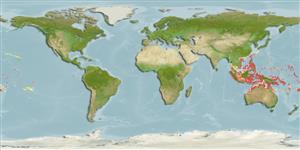Common names from other countries
Teleostei (teleosts) >
Eupercaria/misc (Various families in series Eupercaria) >
Lethrinidae (Emperors or scavengers) > Lethrininae
Etymology: Lethrinus: Greek, lethrinia, a fish pertaining to genus Pagellus.
More on author: Bleeker.
Environment: milieu / climate zone / depth range / distribution range
Ecology
Marine; reef-associated; non-migratory; depth range 5 - 30 m (Ref. 90102). Tropical; 35°N - 20°S, 97°E - 138°W
Pacific Ocean: Indonesia and the Philippines to the Marshall, Solomon and Marquesas islands, north to southern Japan, south to northwest Australia. Easily mistaken (particularly larger individuals) for either Lethrinus microdon or Lethrinus olivaceous. Common at Enewetak and Bikini Atolls (Ref. 37816).
Size / Weight / Age
Maturity: Lm ? range ? - ? cm
Max length : 70.0 cm TL male/unsexed; (Ref. 2295); common length : 40.0 cm TL male/unsexed; (Ref. 2295)
Inhabits lagoons and deeper waters of coral reefs and adjacent sandy bottoms. Solitary in sand or rubble bottoms (Ref. 90102). Feeds mainly on fishes but also on mollusks, crustaceans, and sea urchins (Ref. 1602, 37816). Marketed fresh (Ref. 171).
Life cycle and mating behavior
Maturity | Reproduction | Spawning | Eggs | Fecundity | Larvae
Carpenter, K.E. and G.R. Allen, 1989. FAO Species Catalogue. Vol. 9. Emperor fishes and large-eye breams of the world (family Lethrinidae). An annotated and illustrated catalogue of lethrinid species known to date. FAO Fish. Synop. 125(9):118 p. Rome: FAO. (Ref. 2295)
IUCN Red List Status (Ref. 130435)
CITES (Ref. 128078)
Not Evaluated
Threat to humans
Harmless
Human uses
Fisheries: minor commercial
More information
Common namesSynonymsMetabolismPredatorsEcotoxicologyReproductionMaturitySpawningFecundityEggsEgg development
ReferencesAquacultureAquaculture profileStrainsGeneticsElectrophoresesHeritabilityDiseasesProcessingMass conversion
Tools
Special reports
Download XML
Internet sources
Estimates based on models
Preferred temperature (Ref.
115969): 26.1 - 29.3, mean 28.6 (based on 1747 cells).
Phylogenetic diversity index (Ref.
82804): PD
50 = 0.5000 [Uniqueness, from 0.5 = low to 2.0 = high].
Bayesian length-weight: a=0.00457 (0.00178 - 0.01174), b=3.10 (2.88 - 3.32), in cm Total Length, based on LWR estimates for this (Sub)family-body shape (Ref.
93245).
Trophic level (Ref.
69278): 4.0 ±0.66 se; based on food items.
Resilience (Ref.
120179): Medium, minimum population doubling time 1.4 - 4.4 years (Preliminary K or Fecundity.).
Fishing Vulnerability (Ref.
59153): Moderate to high vulnerability (48 of 100).
